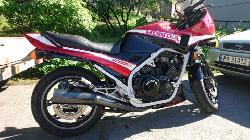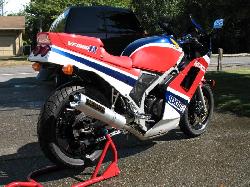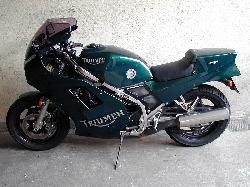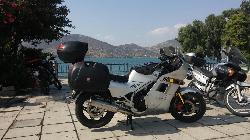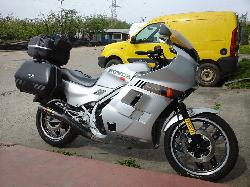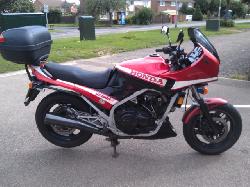998cc DOHC V-4 - The V4 Story
The Honda V-Four heritage can be traced back to Soichiro Honda’s first four-stroke engine designed in 1951 by Kiyoshi Kawashima.Throughout the 60’s Honda had outstanding success with it’s four-stroke engines, both on the road and track. During a 10 year absence from the race track between 1967 and 1977 Honda used the lessons learned from the success on the race track to launch the worlds first superbike, the CB750.
In 1977 journalists gathered in Japan for the launch of Soichiro Irimajiri’s six cylinder CBX and now company president Kiyoshi Kawashima used the occasion to announce Honda’s return to Grand Prix racing. Honda would race in the 500GP’s in 1979, and they would do it with a four-stroke.
Honda had kept up with the two-strokes on the racing track by adding extra cylinders and gears to their four-stroke engines, producing a six cylinder 17,000rpm 250 in 1964 and a five cylinder 125 in 1966. However during Hondas absence from the race track the sports governing body had changed the rules and restricted the 500cc class to four cylinders!
Kawashima had two years to design a new engine and placed CBX designer Irimajiri in charge of the New Racing project. Irimajiri would have loved to have added more cylinders to his engines but the new rules restricted him to four, actually the rules specified four combustion chambers. Legend has it that while sitting in a traffic jam in Japan, Irimajiri was struck by the design of the traffic lights, the lights were contained in oval housings. If he could make the cylinders of the new 500 four-stroke engine oval they could pack in eight valves, four inlet and four exhaust, effectively the motor would be a V8 but with adjacent cylinders conjoined – the V4 was born.
The patent for the oval cylinder engine was filed in March 1978 and by 1979 Honda’s engineers had produced the NR500(0x). What the public saw at Silverstone in August 1979 was completely different to the state-of-the-art motorcycles of the time. Honda’s team of engineers, who had no previous racing experience, had designed the ultimate solution to the design problems experienced on the racing track, from the suspension to the chassis, features that we now take for granted on modern motorcycles were first seen on the NR500, and of course at the heart of the machine was the new oval-piston V4 engine. Each cylinder had four inlet valves, four exhaust valves and two pistons with the opposing cylinder pairs angled at 100˚ making room for the twin-choke carbs to sit nicely in the middle of the Vee. Drive to the NR500’s cam shafts was gear driven and the 0X engine eventually made 115bhp.
Whilst the NR500 had met the 1979 deadline and its design was a success, on the race track it was a failure. Further variants of the bike found some success. In the 2X model ridden by Freddy Spencer the angle between the cylinder heads was reduced to 90˚ and the power output increased to 130bhp, another 5bhp was achieved with the 3X engine.
The true success of the NR500 came from the experience Honda’s research and development team gained from its production and design. Oval pistons may not have been the way forward but the V4 was the ideal power plant for the track and road.
Mass producing the V4 for road going bikes presented Honda with a new set of design challenges. One of the disadvantages of the V4 design is that the rear cylinders are masked by the front cylinders and are positioned at the heart of the bike, beneath tank and rider meaning that they run considerably hotter, especially in an air cooled engine, water cooling was required. The design of the exhaust system is complex and compared to a straight four there is increased cost in producing an extra cylinder head, barrels, bearings, camshaft drive and camshafts.
The advantage the V4 has over the straight-four is that it is narrower, savings can be made on the internal design of the engine with shorter crankshafts and fewer bearings. The carbs fit nicely in the 90˚ VEE formed between the cylinders, and the narrow engine allows for improved streamlining with better ground clearance. The 360˚ crankshaft design gives the engine greater balance and less vibration.
It was this 90˚ V4 with 360˚ crankshafts that appeared in the first road going V4 Honda produced in 1982 – the VF750S. The standard Honda four valves per cylinder were operated by chain-driven double overhead cams. In a departure from normal practice the cam valve clearances were set by threaded tappets instead of shims, this was in response to owners clubs and customers who found it hard to set the clearances themselves. The carbs breathed through an airbox that could be removed providing access to the cylinder heads and tappets with the engine in the frame. The top of the engine was lubricated via an external line to the front cylinders inlet cam and then distributed internally by an H shaped tube.
Commercial success was achieved in the USA with the 750cc V4 packaged into the American VF750S (the Sabre) and the V45 “Magna”, and it was here that Honda customers problems with the V4 engine began. The fault manifested itself as uneven idling that caused the bike to stall. Honda’s decision to change the adjustment of the valve clearances was costly, as incorrectly set valve clearances was identified as one of the causes of the problem. A “special tool” was recommended to assist in the correct setting and tightening of the clearance and tappet lock nuts which was to prove to be the cause of more problems to come.
With the success of the Sabre and Magna in the US, Honda set their sights on the American TT F1 championship to try and regain their sporting reputation. The regulations specified that major engine castings be retained from the homologation bike, so Honda took a set of VF750 crankcases, barrels and cylinder heads and built a racing engine around the inside of them, the result was the FWS1000. With a reported $3.5 million invested in the F1 season it was not surprising that the V4 powered FWS would blow the competition away.
The major difference in the FWS engine was that the cam shafts were driven by gears and not chains, and the final drive was by chain and not shaft. The engine was bored out to 1024cc and made over 150bhp. The steel cradle chassis was enveloped in a full race fairing, and the bike had pro link suspension with 16 inch front and 18 inch rear wheels.
A year later the public would be buying this bike as the VF1000R…
